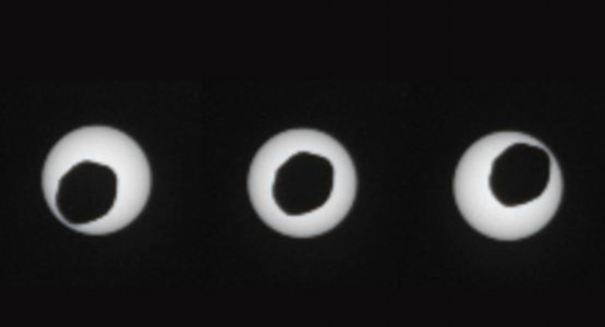
The rover interrupted its journey on August 17 to document the solar eclipse.
According to a news release from NASA, the space agency’s Curiosity rover has captured the sharpest-ever images of a solar eclipse as seen from Mars. The photos were obtained with a telephoto-lens camera located on Curiosity and show the biggest of Mars’ two moons, Phobos, passing directly in front of the Sun.
This particular solar eclipse is known as an annular type, because Mars’ moon does not completely cover the Sun, as observed from the Martian surface. You can view a set of three frames taken by the rover’s Mast Camera here. They were captured three seconds apart as Phobos eclipsed the Sun.
According to NASA, the photos are the first full-resolution frames sent back to Earth from an August 17, 2013, series. The space agency notes that the series may later become part of a movie of the annular eclipse. The rover interrupted its journey on August 17 to document the solar eclipse.
“This event occurred near noon at Curiosity’s location, which put Phobos at its closest point to the rover, appearing larger against the sun than it would at other times of day,” said Mark Lemmon of Texas A&M University, an expert on the utilization of Curiosity’s Mastcam, in a statement to NASA. “This is the closest to a total eclipse of the sun that you can have from Mars.”
Curiosity and Opportunity’s observations of Phobos and Deimos are assisting researchers with their effort to obtain a more detailed understanding of the moons’ orbits. According to NASA, the location of Phobos crossing the Sun was a mile or two closer to the center of the Sun’s position than scientists expected.
“This one is by far the most detailed image of any Martian lunar transit ever taken, and it is especially useful because it is annular. It was even closer to the sun’s center than predicted, so we learned something,” Lemon added.
According to NASA, Phobos is on a collision course with Mars. The moon, which is 27 by 22 by 18 km in diameter, is approaching the Red Planet at a rate of 1.8 m every hundred years. This means that Phobos will either smash into Mars in 50 million years or break up into a ring.
Phobos orbits the Red Planet three times a day, and is so close to the Martian surface that in some places on Mars it cannot always be observed.
What do you think of Curiosity’s images of Phobos passing in front of the Sun? Share your thoughts in the comments section.
Leave a Reply